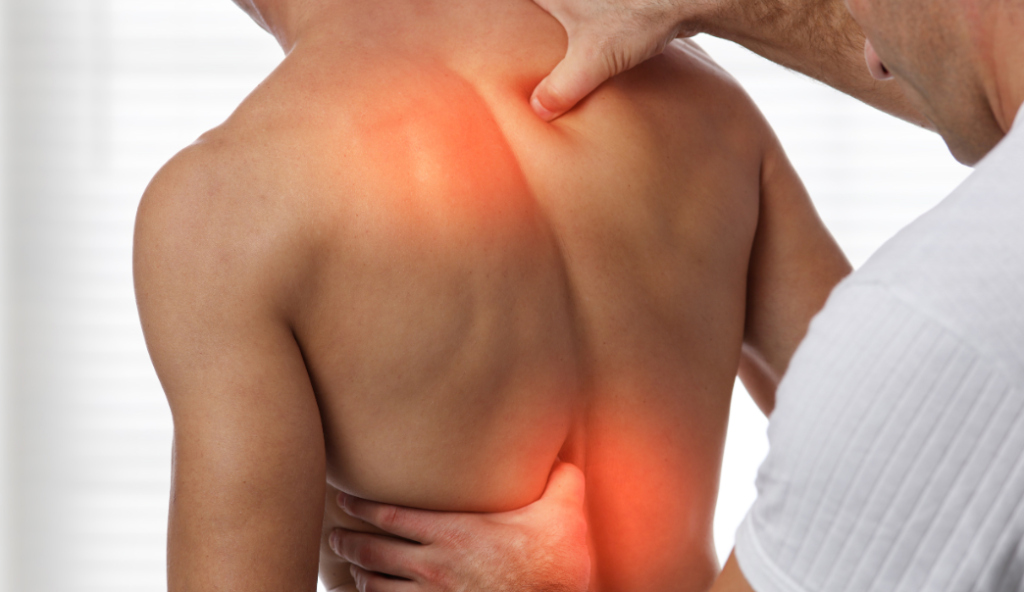Do you find yourself frequently dealing with back pain? If so, you may be experiencing dorsalgia. Dorsalgia, commonly known as back pain, can affect individuals of all ages and genders, and a variety of factors can cause it. This comprehensive overview will delve into dorsalgia’s different types and characteristics, explore its causes and risk factors, discuss the symptoms and diagnosis process, explore various treatment options, and provide prevention tips.
Whether you are currently dealing with dorsalgia or want to understand it better, this article will provide the needed knowledge.
Differentiating Dorsalgia: Types and Characteristics
Kicking off our exploration of dorsalgia, let’s first understand the different types and characteristics. Dorsalgia, commonly known as back pain, can be broadly classified into two categories: acute and chronic. Acute dorsalgia refers to sudden and severe pain that typically lasts for a short duration. In contrast, chronic dorsalgia is pain that persists for extended periods, typically over three months.
Within these categories, there are several specific types of dorsalgia. For instance, axial dorsalgia affects the central part of the back, while radicular dorsalgia radiates from the spine to other body parts. Axial dorsalgia is often associated with muscle strains, poor posture, or overuse injuries. In contrast, radicular dorsalgia is commonly caused by nerve compression, such as in cases of herniated discs or spinal stenosis. Understanding the characteristics and differences between these types of dorsalgia is crucial for accurate diagnosis and appropriate treatment.
Let’s delve deeper into the characteristics of acute and chronic dorsalgia to gain a better understanding.
Understanding Acute Dorsalgia
Acute dorsalgia often occurs suddenly, usually following an injury or trauma to the back. This type of back pain can be sharp and intense and may limit your ability to move comfortably. It can make even simple tasks difficult and can have a significant impact on your quality of life. Acute dorsalgia can be caused by various factors, including muscle strains, ligament sprains, or sudden movements that put excessive stress on the back.
When experiencing acute dorsalgia, it is essential to rest and avoid activities that exacerbate the pain. Applying ice packs or using over-the-counter pain medications can help alleviate the discomfort. Physical therapy exercises and gentle stretching may also be recommended to improve flexibility and strengthen the muscles supporting the back. The good news is that acute dorsalgia often resolves independently with proper care and self-management techniques.
Unpacking Chronic Dorsalgia
Unlike acute dorsalgia, chronic dorsalgia is a persistent condition that can significantly affect an individual’s daily life. It may arise due to an unresolved sensitive case, but it can also emerge gradually without any specific injury or trauma. Chronic dorsalgia is often associated with underlying medical conditions such as arthritis, degenerative disc disease, or fibromyalgia.
Living with chronic dorsalgia can be challenging, as the pain may be constant or intermittent, and it can interfere with work, sleep, and overall quality of life. Individuals with chronic dorsalgia may experience muscle stiffness, decreased range of motion, and fatigue. It is essential to seek the assistance of healthcare professionals for an accurate diagnosis and personalized treatment plan.
Treatment options for chronic dorsalgia may include a combination of medication, physical therapy, chiropractic care, and alternative therapies such as acupuncture or massage. In some cases, surgical intervention may be necessary to alleviate the underlying cause of the pain.
It is important to remember that each individual’s experience with dorsalgia is unique, and treatment plans should be tailored to address their specific needs and circumstances. By understanding the types and characteristics of dorsalgia, healthcare professionals can provide appropriate care and support to help individuals manage their pain effectively and improve their overall well-being.
Causes and Risk Factors of Dorsalgia
Now that we have explored dorsalgia’s different types and characteristics, let’s focus on understanding this condition’s causes and risk factors. Dorsalgia, commonly known as back pain, can have various underlying causes, ranging from muscle strains and sprains to more severe spinal conditions.
Poor Posture
One of the most common causes of dorsalgia is poor posture. Many individuals spend long hours sitting or standing in positions that strain the muscles and ligaments of the back. Over time, this can lead to muscle imbalances and chronic pain. Similarly, a sedentary lifestyle, characterized by a lack of physical activity, can weaken the muscles that support the spine, making individuals more susceptible to back pain.
Obesity
Obesity is another significant risk factor for dorsalgia. Excess weight stresses the spine, increasing pressure on the intervertebral discs and joints. This can result in inflammation, pain, and reduced mobility. Age-related degeneration is also a common cause of dorsalgia. As we age, the discs in our spine naturally lose their cushioning ability, leading to herniated discs and spinal stenosis.
While physical factors play a significant role in the development of back pain and stiffness, trauma from accidents or sports injuries can also be a cause. Sudden impacts or excessive force on the back can result in sprains, strains, or fractures, leading to acute or chronic pain. It is essential to seek medical attention after such incidents to prevent further complications.
Heavy Lifting and Prolonged Sitting
In addition to the causes mentioned above, several risk factors can increase the likelihood of developing dorsalgia. Individuals who engage in repetitive activities, such as heavy lifting or prolonged sitting, are at a higher risk of experiencing back pain. The repetitive stress on the back can lead to muscle fatigue and strain. Moreover, smoking, which affects blood flow and oxygen supply to tissues, can also contribute to the development of dorsalgia. The chemicals in cigarettes can damage the spinal discs and impair the body’s natural healing process.
Furthermore, psychological factors such as stress, anxiety, and depression can exacerbate existing back pain or increase the risk of developing it. When under stress, the body releases stress hormones that can cause muscle tension and tightness, leading to discomfort and pain in the back. Additionally, individuals who experience chronic stress or have underlying mental health conditions may be more prone to adopting poor posture or engaging in unhealthy habits that contribute to dorsalgia.
It is important to note that dorsalgia’s causes and risk factors can vary from person to person. While some individuals may develop back pain due to a specific cause, others may experience a combination of factors contributing to their condition. Understanding these causes and risk factors can help individuals make lifestyle changes and seek appropriate treatment to manage and prevent dorsalgia.
Symptoms and Diagnosis of Dorsalgia
Recognizing the symptoms of dorsalgia and obtaining an accurate diagnosis is crucial for effective management. The primary symptom of dorsalgia, of course, is pain in the back region. However, the pain can vary in intensity, location, and duration, depending on the underlying cause. Some individuals may experience a dull, constant ache, while others may feel sharp, shooting pain.
In addition to pain, other common symptoms of dorsalgia include stiffness, limited range of motion, muscle weakness, and radiating pain that extends to the arms or legs. If you experience these symptoms, you must visit a healthcare professional for a thorough examination and diagnosis. Medical professionals may use a combination of physical examination, imaging tests, and medical history analysis to determine the underlying cause of your dorsalgia.
Treatment Options for Dorsalgia
Regarding managing back pain, several treatment options are available, depending on the severity and underlying cause of the pain. The initial approach to treatment typically involves conservative measures such as rest, ice or heat therapy, over-the-counter pain medications, and gentle stretching exercises. These measures aim to reduce pain and inflammation and promote healing.
If conservative measures do not provide sufficient relief, healthcare professionals may recommend more advanced treatments. Physical therapy, chiropractic care, and acupuncture are the non-surgical interventions that can help alleviate dorsalgia symptoms. In some cases, when conservative treatments fail to provide relief, a surgical procedure may be necessary to address the underlying cause of the pain.
Role of Physical Therapy and Chiropractic Care
Physical therapy plays a pivotal role in the management of dorsalgia. Physical therapists can design customized exercise programs to strengthen the muscles supporting the spine, improve flexibility, and correct postural imbalances. On the other hand, chiropractic care focuses on spinal manipulation and adjustment techniques to relieve pain, restore joint mobility, and improve overall spinal health.

Lifestyle Changes and Home Remedies for Dorsalgia Relief
In addition to professional treatments, making lifestyle changes and using home remedies can provide supplementary relief for dorsalgia. Maintaining a healthy weight, practicing good posture, and incorporating regular exercise into your routine can help prevent and manage back pain. Additionally, applying hot or cold packs, taking warm baths, and using over-the-counter topical analgesics can temporarily relieve acute episodes of dorsalgia.
Stress-reducing activities like yoga, meditation, and deep breathing exercises can also help alleviate dorsalgia symptoms. It is essential to note that these lifestyle changes and home remedies work best when combined with professional guidance and appropriate medical advice. Consulting with healthcare professionals will ensure these strategies are safe and effective for your condition.
Dorsalgia in Athletes: A Special Consideration
Athletes, both amateur and professional, often face unique challenges when managing dorsalgia. The demands of their rigorous training, intense physical activity, and individual sports can contribute to developing or exacerbating back pain. Athletes must prioritize their spine health and work closely with healthcare professionals specializing in sports medicine.
Prevention becomes crucial for athletes. Proper warm-up and cool-down exercises, incorporating core strengthening routines, and using the right equipment and techniques are essential in reducing the risk of dorsalgia. Athletes should also focus on maintaining overall fitness and flexibility to support their spine and minimize the impact of physical stress on their backs.
Preventing Dorsalgia: Tips and Strategies
Prevention is always better than cure, and the same applies to dorsalgia. By taking proactive measures, you can significantly reduce the likelihood of experiencing back pain. One of the critical strategies for preventing dorsalgia is maintaining a healthy lifestyle. Regular exercise, a balanced diet, and avoiding tobacco use can aid in maintaining optimal spine health and overall well-being.
Additionally, good posture is essential, especially during activities such as sitting, standing, and lifting heavy objects. Using ergonomic furniture and taking frequent breaks from prolonged sitting can also help reduce the strain on your back. Regular stretching and strengthening exercises focusing on the back and core muscles can enhance back stability and minimize the risk of dorsalgia.
When to Seek Medical Advice for your back pain
While many cases of dorsalgia can be managed with self-care and conservative measures, there are situations where seeking medical advice is crucial. If you experience persistent or worsening pain that does not improve with rest and self-management, it is essential to consult with a healthcare professional. Similarly, prompt evaluation by a medical professional is warranted if you notice any accompanying symptoms such as numbness, tingling, or weakness in your extremities.
It is also crucial to seek immediate medical attention if your dorsalgia is the result of a significant injury, such as a fall, car accident, or sports-related trauma. In these cases, a thorough evaluation is necessary to rule out any severe spinal injuries or fractures. Remember, early medical intervention and appropriate treatment can contribute to a more successful recovery and prevent potential complications.
Future Directions in Dorsalgia Research and Treatment
As medical knowledge advances, researchers and healthcare professionals continually explore new avenues for understanding and managing dorsalgia. Emerging technologies, such as virtual reality and artificial intelligence, show promise in providing innovative treatment approaches. Additionally, ongoing research is focused on identifying molecular targets and developing novel pharmacological interventions to reduce pain and promote healing.
Furthermore, there is an increasing emphasis on personalized medicine in dorsalgia. Tailoring treatments based on an individual’s unique characteristics and genetic makeup holds significant potential for optimizing outcomes and reducing the burden of dorsalgia. With the constant advancements in research and treatment options, the future looks promising for individuals with dorsalgia.
Dorsalgia can significantly impact an individual’s quality of life. Understanding the different types, causes, symptoms, and available treatment options is crucial for effective management. By incorporating lifestyle changes, seeking professional guidance, and practicing preventive strategies, individuals can minimize the risk of developing dorsalgia and enhance their overall spine health. Early intervention and comprehensive care are essential to long-term relief and improved well-being.
Take charge of your back health today!


